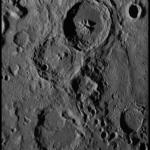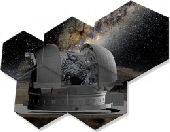[3D-Model by Marco Campaniello]
Thanks so much to my friend Marco Campaniello for 3D-Model computation of the image
Italiano:
Ecco una nuova ripresa, un pò più dettagliata della precedente già pubblicata il 18 Ottobre 2019, di una famosa “Triade” di crateri lunari: i crateri Teophilus, Cyrillus e Catharina, situati nella zona centro sud-orientale della faccia a noi visibile della Luna, visibili anche con piccoli telescopi 5 giorni dopo la Luna nuova (quindi in fase crescente) oppure, come in questa mia ripresa, 6 giorni dopo la Luna piena.
Si tratta di tre crateri tutti estesi all’incirca 100 chilometri e di formazione molto antica, sebbene Teophilus (il primo dei tre dall’alto) sia più recente (da 3,2 a 1,1 miliardi di anni fa) degli altri due.
L’orlo di “Teophilus” ha un’ampia superficie interna terrazzata che mostra segni di frane. Il cratere ha una profondità di 4200 metri (!) con pareti massicce che si sono fratturate, scontrandosi nell’impatto originario, con una seconda formazione preesistente: il cratere Cyrillus. Esso ha un’imponente montagna centrale, alta 1.400 metri, con tre picchi di grandezze scalari, molto videnti, di cui il picco occidentale è designato Psi (ψ), quello orientale Phi (φ) e il picco settentrionale è Alpha (α).
Il cratere “Cyrillus” è un cratere da impatto lunare situato sul bordo nord-ovest del Mare Nectaris, ed è il centrale dei tre in questa mia immagine. Il cratere Teofilo, di impatto successivo come già detto, si intromette nel bordo nord-est. Le pareti del cratere Cyrillus rimangono intatte fino al punto di congiunzione con Teophilus.
Il fondo di Cyrillus contiene tre ridotte montagne centrali leggermente a nord-est del suo centro, che si innalzano ad altezze di 1.000 metri sopra il pavimento di Cyrillus: Cyrillus Alpha, Delta ed Eta.
Il terzo ed ultimo dei tre, il cratere “Catharina” (in basso nell’immagine), si trova in un aspro tratto di terreno lunare tra la scarpata chiamata Rupes Altai (ad ovest di esso) e il Mare Nectaris (ad est) e tutto il trio di crateri è incorniciato dalla curva delle “Rupes Altai”.
Il bordo di Catharina è fortemente usurato e irregolare e nulla rimane dell’originario picco centrale. La maggior parte della parete nord è incisa dal bordo consumato del cratere Catharina-P, mentre la parete nord-est è profondamente bombardata da numerosi crateri più piccoli.
Sono presenti, nell’immagine ripresa, anche il cratere “Beaumont”, il cratere “Ibn-Rushd” (o Averroes) ed il Mons Penck.
Quest’ultimo, è un promontorio (in alto a sinistra nell’immagine) che si trova appena a nord-est del cratere Kant, a nord di Ibn-Rushd e della scarpata Rupes Altai, ha un diametro alla base di circa 30 km e risale fino ad un’altitudine di oltre 4 km !!
Dettagli tecnici:
Telescopio Astrofaktorja DK20″ @ ~ F/27 – Player One Saturn M camera – TeleVue Powermate Barlow 2x – Baader R filter (~580nm) – Seeing ~ 6,5/10 (max.) in R band – sito: Palermo @ my personal Observatory.
***********************************************************************************************************
English:
The latter is a promontory (top left in the image) located just north-east of the Kant crater, north of Ibn-Rushd and the escarpment Rupes Altai, has a diameter at the base of about 30 km and rises to an altitude of over 4 km!!
Astrofaktorja DK20″ telescope @ ~ F/27 – Player One Saturn M camera – TeleVue Powermate Barlow 2x – Baader R filter (~580nm) – Seeing ~ 6.5/10 (max.) in R band – site: Palermo @ my personal Observatory.


